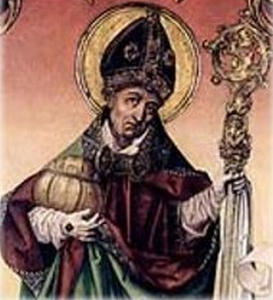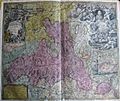Prince-Archbishopric of Salzburg facts for kids
Quick facts for kids
Prince-Archbishopric of Salzburg
|
|||||||||
|---|---|---|---|---|---|---|---|---|---|
| 1328–1803 | |||||||||

Salzburg territory (blue) in 1648
|
|||||||||
| Status | Prince-Archbishopric | ||||||||
| Capital | Salzburg | ||||||||
| Government | Prince-Archbishopric | ||||||||
| Prince-Archbishop | |||||||||
|
• 1772–1803
|
Count Hieronymus von Colloredo (last) | ||||||||
| Historical era | Middle Ages | ||||||||
|
• Diocese founded
|
739 | ||||||||
|
• State constitution
|
1328 | ||||||||
|
• Joined Bavarian Circle
|
1500 | ||||||||
|
• Salzburg Cathedral consecrated
|
1628 | ||||||||
|
• Secularised to electorate
|
1803 | ||||||||
| 1805 | |||||||||
| Currency | Salzburg Thaler | ||||||||
|
|||||||||
The Prince-Archbishopric of Salzburg was a special kind of state in the Holy Roman Empire. It was ruled by an Archbishop who was also a prince, meaning he had both religious and political power. This area was different from the larger Roman Catholic Archdiocese of Salzburg, which was just the church's territory.
The capital city was Salzburg, which used to be a Roman city called Iuvavum. From the late 1200s, the archbishops slowly gained independence from the dukes of Bavaria. Salzburg remained a prince-archbishopric until 1803. At that time, it lost its political power and became the Electorate of Salzburg.
The archbishops of Salzburg were very important. They held the title Primas Germaniae, meaning "First Bishop of Germany." One famous Prince-Archbishop was Count Hieronymus von Colloredo, who was a supporter of the famous composer, Wolfgang Amadeus Mozart.
Contents
Where Was Salzburg Located?
The Prince-Archbishopric of Salzburg covered an area similar to the modern-day Austrian state of Salzburg. It stretched along the Salzach river. In the south, it reached the high Alps, with mountains like Großvenediger (3,666 meters high). In the north, it extended to the lower Alpine foothills.
The land was traditionally divided into five main parts:
- Flachgau and Tennengau: These were in the wide Salzach valley, near the capital city of Salzburg and the town of Hallein.
- Pinzgau, Pongau, and Lungau: These were mountainous regions in the south, including areas around Bischofshofen and Tamsweg.
Salzburg shared borders with several important areas. To the north and east was the Duchy of Austria, which later became the powerful Habsburg monarchy. The Salzkammergut region, famous for its salt, was slowly taken over by the Habsburgs. To the southeast was the Duchy of Styria, and to the south, the Duchy of Carinthia. In the west, Salzburg bordered the County of Tyrol. Only in the northwest did it border the Duchy of Bavaria and the small Berchtesgaden Provostry.
Early History of Salzburg
The area around Salzburg has a long history. Around 450 AD, during the fall of the Roman Empire, the city of Iuvavum already had churches and a monastery. However, not much is known about this early time. The city was abandoned around 487/88 AD.
The Bavarian Bishopric
Around the 6th century, Germanic tribes called the Bavarii settled in the northern parts of the region. Later, around 696 AD, Saint Rupert arrived. He was a bishop from the Frankish kingdom. He helped to restart Christianity in the area.
Rupert found the ruins of Iuvavum and saw that some people still lived there and kept Christian traditions. He built a monastery dedicated to Saint Peter in the old city. This monastery, St Peter's Abbey, received a lot of land. It also got control of salt wells and salt ponds. This is how Iuvavum got its German name, Salzburg, which means "Salt Castle."
In 739 AD, Saint Boniface, with the Pope's approval, made Salzburg a bishopric. This meant it was an official church district led by a bishop.
Becoming an Archbishopric
In 798 AD, Bishop Arno became the first Archbishop of Salzburg. He was given a large area to spread Christianity, including parts of Carinthia. Monasteries were built, and many people became Christian.
Later, there were some difficult times. In the 900s, the Magyars (a nomadic group) attacked the region, destroying churches. But after a big defeat for the Magyars in 955 AD, life in Salzburg returned to normal.
The Investiture Controversy
Around 1060, the Christian world faced a big conflict called the Investiture Controversy. This was a disagreement between the Pope and the Holy Roman Emperor about who had the right to appoint bishops.
Gebhard, the Archbishop of Salzburg at the time, supported the Pope. Because of this, he had to live in exile for nine years. This shows how important the archbishops were, even in big political struggles.
The Prince-Archbishopric State

In 1213, Archbishop Eberhard II of Regensberg was officially made a prince of the Empire. This meant he had the same status as other princes in the Holy Roman Empire, giving him significant political power. He also created three new bishoprics: Chiemsee, Seckau, and Lavant.
During the 1300s, the Black Death arrived in Salzburg in 1347. This terrible plague caused a lot of suffering.
Later, Leonhard von Keutschach (who ruled from 1495 to 1519) was a strong leader. He even had local officials arrested for unfair taxes. His time was followed by Matthäus Lang von Wellenburg, who faced challenges as Protestant ideas began to spread from Saxony. He tried to keep the people Catholic, which led to some uprisings.
Archbishop Wolf Dietrich von Raitenau (1587–1612) gave Protestants a choice: convert to Catholicism or leave Salzburg. He also rebuilt the Salzburg Cathedral in a very grand style.
Archbishop Paris of Lodron (1619–1653) was very wise. He managed to keep Salzburg peaceful and prosperous during the Thirty Years' War. This was a terrible war that devastated much of Germany, but Salzburg was largely spared.
Another important event happened under Leopold Anton von Firmian (1727–1744). He ordered the remaining Protestants in Salzburg to either change their beliefs or leave. Over 20,000 Salzburg Protestants were forced to leave their homes. Many of them moved to Prussia.
The last Prince-Archbishop was Hieronymus von Colloredo (1772–1812). He is famous for being the boss and supporter of the young Wolfgang Amadeus Mozart. Colloredo tried to make changes to the church and education, but these changes made him unpopular with the people.
The End of the Prince-Archbishopric
In 1803, the Prince-Archbishopric of Salzburg lost its political power. This process was called secularisation. It became the Electorate of Salzburg, a new state for Ferdinand III, who had lost his own kingdom.
In 1805, Salzburg became part of Austria. Then, in 1809, it became part of Bavaria. During this time, the University of Salzburg was closed, and monasteries were not allowed to accept new members. Pilgrimages and religious processions were also banned.
In 1818, the church's role in Salzburg was re-established as the Roman Catholic Archdiocese of Salzburg, but it no longer had political power.
Even today, the Archbishop of Salzburg holds the special title Primas Germaniae ("First Bishop of Germany"). This means they are the Pope's main contact in the German-speaking world. The Archbishop also has the title of Legatus Natus ("born legate"), which allows them to wear red robes, even though they are not a cardinal.
Notable Archbishops of Salzburg
Here are some of the important Archbishops who led Salzburg throughout its history:
- Rupert of Salzburg (696–716/18) - The founder of the modern diocese.
- Virgil of Salzburg (746–784)
- Arno of Salzburg (784–821) - The first Archbishop.
- Gebhard of Salzburg (1060-1088) - Supported the Pope during the Investiture Controversy.
- Conrad I of Babenberg (1106–1147)
- Eberhard II of Regensberg (1200–1246) - Became a Prince of the Empire in 1213.
- Leonhard von Keutschach (1495–1519) - A strong leader who reformed the state.
- Matthäus Lang von Wellenburg (1519–1540) - Faced the start of the Protestant Reformation.
- Wolf Dietrich von Raitenau (1587–1612) - Rebuilt the cathedral.
- Paris von Lodron (1619–1653) - Kept Salzburg peaceful during the Thirty Years' War.
- Leopold Anton von Firmian (1727–1744) - Ordered the expulsion of Protestants.
- Sigismund III of Schrattenbach (1753–1771)
- Hieronymus von Colloredo (1772–1812) - The last Prince-Archbishop and patron of Mozart.
Images for kids
See also
 In Spanish: Principado-arzobispado de Salzburgo para niños
In Spanish: Principado-arzobispado de Salzburgo para niños
- Alte Residenz – a city palace in Salzburg
- Schloss Hellbrunn – a summer palace near Salzburg





